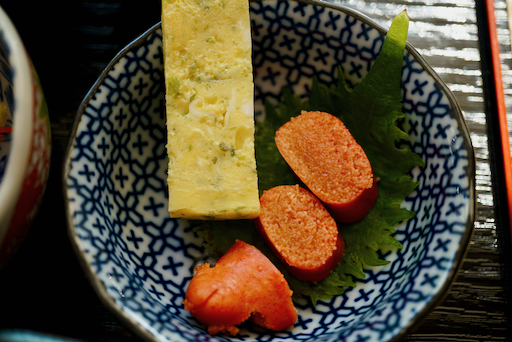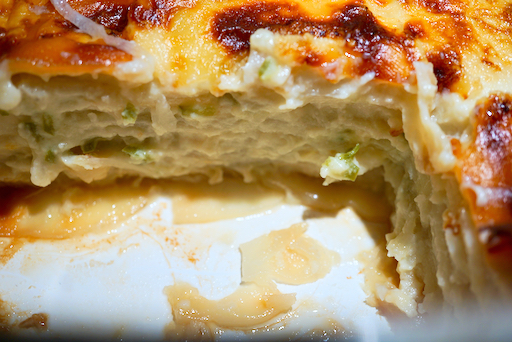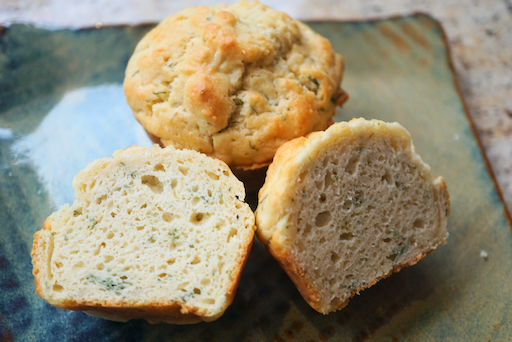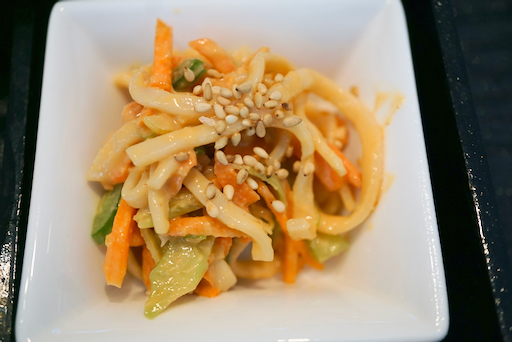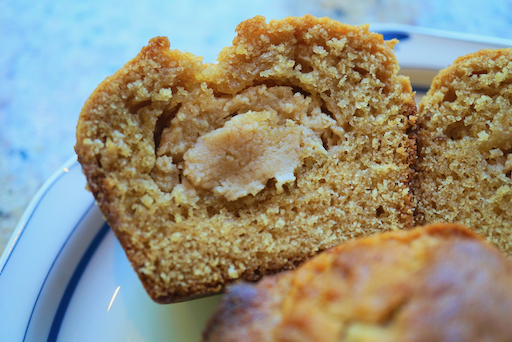Lightly grilled salted "tarako" たらこ cod roe is not really a new dish as I posted it many years ago, but it is a very common dish in Izakaya and goes perfectly well with sake. I usually get tarako (frozen) from our Japanese grocery store, but this time I got it from Hmart, the Korean grocery store, through Instacart. The groceries were delivered while I was not at home so my wife received them. During a subsequent phone call, she mentioned that it was not a completely successful grocery run since the three types of fresh mushrooms and the mackerel we ordered were not available. The good news was that the "tarako" did arrive. She said something was wrong, however, because it was covered with a red goopy stuff and suggested that maybe the little egg sacks had somehow ruptured spilling their contents. (Not good!) So when I got back in the evening and inspected the tarako I found it was coated with a Korean hot sauce "gochujang". We were both relieved and had a good chuckle. Since we are not into very hot spicy food, I quickly rinsed off the hot sauce. I made "Tarako" pasta たらこスパゲッティwith it and it was just fine. I made the dish shown below from the last sac of tarako. I just cooked it in the toaster oven until the surface was cooked but the insides were still raw. I served it with a Dashimaki omelet だし巻き I had made.
Monday, May 31, 2021
Tarako from Korean grocery store Hmart 焼きたらこ
Friday, May 28, 2021
Eggplant in seasoned broth 茄子のお浸し
We got 2 fairly large Japanese (or also called Chinese or Asian) eggplants (long and light purple colored). So, one evening, I made this dish from one of them. This is based on a recipe I found on-line. It was a shortcut recipe since the eggplant was microwaved but it turned out pretty good.
Ingredients: (makes about 6 small appetizer servings like in the first picture)
One Japanese eggplant (this was large about 10 inch long)
For seasoned broth (mix first two items)
1/4 cup Bonito dashi broth (As usual I made this from a dashi pack).
1/4 cup or "to taste" concentrated Japanese noodle sauce (from the bottle)
Dried bonito flakes for topping.
Directions:
Remove the stem end of the eggplant and remove the skin in stripes using a vegetable peeler,
Cut lengthwise into two pieces.
Cut the two pieces further into bite sized pieces (called "ran-giri" 乱切り, cut in 45 degree angle as you rotate 90 degree).
Immediately soak in salted cold water for 10 minutes (water darkens).
Wash in cold running water.
Place the eggplant in a silicon container for microwave cooking and microwave for 1 minute (depending on the size of the eggplant and the wattage of the microwave oven).
Let it cool down until it can be safely handled.
Place the eggplant in the seasoned broth and refrigerate for a few hours.
Top with the bonito flakes just before serving.
Since this type of eggplant is not as "bitter" or astringent as Western eggplant, soaking in salted water and microwaving worked. The skin is also much more tender than that of Western eggplants. The seasoned both really made this dish. Perfect gentle cold dish for summer.
Tuesday, May 25, 2021
Scalloped potato with cauliflower puree
My wife came up with this dish one day. A few days before I had made my usual Cauliflower puree. Beside eating it as an “adult baby” food, we have made Mac-and-cheese using the puree instead of Béchamel sauce. I am not sure how she came up with this dish but, it is essentially scalloped potatoes made with the Cauliflower puree, cheese, onion and jalapeño pepper. This was topped with several kinds of cheese and baked.
Two russet potatoes thinly sliced
2 onions thinly sliced
2 jalapeño pepper
1 cup of cheddar cheese grated
1 cup monterey Jack cheese grated
1/2 cup parmesian cheese grated
Several slices of smoked gouda to top.
Enough cauliflower puree to cover several layers
Directions:
Cover the bottom of an oven casserole dish with the puree. Distribute a layer of potatoes (#1) then the sliced onions, jalapeño pepper and the various cheeses (# 1&2) then the cauliflower pure (#3) Keep layering until all the ingredients have been distributed. End by putting on slices of smoked gouda (#4). Cook in a 400 degree oven covered for 30 minutes. Remove the cover and continue cooking for 30 minutes until the potatoes are tender and a knife slides in easily. Let cool for 15 minutes before serving.
This is a very comforting dish with thin layers of potatoes between custard like layers of warm cheese. The jalapeño peppers and onion give a nice flash of flavor. You would never guess that cauliflower was one of the main ingredients. It heated up nicely in the microwave. This would the a staple for any menu.
Saturday, May 22, 2021
Warm tofu with shiitake sauce 豆腐の椎茸あんかけ
For some reason, it is getting more and more difficult to get fresh whole shiitake mushrooms. Our regular grocery store used to carry them but now only pre-sliced shiitake are available. Whole foods used to have them regularly but it is now hit or miss. This time, we tried Hmart, Korean grocery store, through Instacart. Despite the specific instruction that we wanted only whole fresh shiitake, we got pre-sliced. I decided to cook them so that they would keep longer and if needed I could also freeze them. So I just sautéed the mushrooms with olive oil, finely chopped red onion (I happened have extra finely chopped red onion left over from another dish). Several days later, I made this warm tofu dish from silken tofu (right, in the first picture). I also served fried salmon in sweet vinegar 鮭の南蛮漬け topped with ikura (left in the first picture)
Ingredients:(two small servings)
1/4 silken tofu, cut into two cubes
1 inch long dried kelp (for making broth)
Water
For "ankake" 餡掛け sauce
1/2 cup (arbitrary) sliced fresh shiitake mushroom (in my case mixture of finely chopped onion and pre-sliced shiitake sautéed in olive oil)
1/2 cup dashi broth (I used bonito broth using dashi pack)
1 tsp potato starch ("katakuri-ko")
1 tbs sake
1-2 tsp of concentrated noodle sauce (from bottle) to taste.
1/4 tsp grated ginger
chiffonade of perilla (optional)
Directions:
Wipe the kelp with a wet towel. Put in a pan and add water. When it comes to boil turndown the flame to simmer and add the tofu cubes to warm (5-10 minutes)
In a small sauce pan, add the bonito broth and the shiitake. Let it come to boil then turn down the flame to simmer. Cook for a few minutes. Add the concentrated noodle sauce to taste. Thicken the sauce by mixing in the potato starch slurry (with sake) and cook for few more minutes. Add the grated ginger and cut the heat.
In a bowl, carefully scope up the warm tofu cubes with a slotted spoon draining water. Pour over the "ankake" sauce and garnish with chiffonade of perilla (if using).
This is a nice, very gentle dish with soft and warm silken tofu with mild flavors of soy sauce, broth and shiitake. Although the day was not cold, we enjoyed this with cold sake.
Wednesday, May 19, 2021
Blueberry pancake v2 ブルーベリーパンケーキ V2
We always associate fresh blueberries with early summer, although they are now available year-around because they are also produced in South America. One way we enjoy blueberries is by making blueberry pancakes. Recently my wife was talking to her sister, and mentioned that we had just enjoyed blueberry pancakes for breakfast that day. Her sister asked for the recipe and my wife said it was in "The Joy of Cooking" (JOC). (This cookbook is a quintessential fixture of American kitchens and has been continuously published since 1936.) Sometime later her sister mentioned that she had made blueberry pancakes and they were really gourmet because of the addition of cornmeal and lemon zest. My wife was confused because the JOC recipe she was familiar with did not include cornmeal or lemon zest. As a matter of fact there was no recipe in the pancake section of her JOC that mentioned those two items. So she went back to her sister and asked how she had calculated the amount of cornmeal to substitute for the regular flour called for in the recipe. Her sister replied that she had just followed the recipe in the cookbook. Then it dawned on my wife that her sister was using a different edition of JOC than the one my wife was using. It turns out that my wife's blueberry pancake recipe is from the 1980 edition and the recipe her sister used was from the 1997 edition, (which my wife also has). (I think the newest edition is 2019)**. In any case, my wife decided to try the 1997 edition blueberry pancake recipe her sister had used.
**Digression alert. We basically stuck with the older version of the cookbook because it was the one we were familiar with and particularly once we noticed that some of our favorite recipes from the old cookbook were not in the new cookbook. From an esoteric point of view, I particularly missed the section on how to prepare wild game that was in the old cook book. Although I may never have to use the knowledge that grey squirrels taste better than red squirrels because red squirrels are quite gamy in flavor or that squirrels should be skinned while wearing gloves to prevent possible tularemia infection, it is nice to know such information is available. Not to mention the "must have" recipes for opossum, porcupine, raccoon or muskrat.
Here I asked my wife to take over.
Ingredients:
2 cups AP flour
1 cup yellow cornmeal
1/2 cup sugar
2 1/2 tsp baking powder
1/2 tsp baking soda
1/2 tsp salt
2 1/2 cups buttermilk
8 Tbs. (one stick) butter melted
4 large eggs separated
3 tsp lemon zest
Directions:
Mix the dry ingredients flour through salt in a mixing bowl.
Mix the wet ingredients, buttermilk through the 4 egg yolks in another bowl.
Add the lemon zest to the wet ingredients.
Whip the 4 egg whites until peaks are stiff but not dry.
Mix the wet ingredients into the dry ingredients until just combined.
Carefully fold the whipped egg whites into the batter.
Put a teaspoon of olive oil in a frying pan then scoop a ladle full of batter into the preheated pan and cook until done flipping once.
These pancakes, like the previous version, are very good. Both are nicely fluffy and have a pleasant mildly sweet taste with a lovely burst of flavor from the blueberries. This version has the addition of a mild lemon flavor. We didn't detect any addition flavor added by the cornmeal. Both recipes make a mighty fine pancake.
Sunday, May 16, 2021
Salmon "ruibe" frozen sashimi 鮭のルイベ
One evening, we wanted to have one more appetizer to go with the cold sake we were enjoying. I remembered that we had frozen sashimi-grade salmon from Catalina Offshore products in the freezer but it was a one pound piece and would take too long to defrost. Then, it occurred to me that we could have "ruibe" ルイベ which is frozen raw salmon shaven into thin pieces to eat as a kind of sashimi. This dish is supposedly derived from the way the indigenous people who lived in Hokkaido 北海道 known as "Ainu" アイヌ used to eat salmon. Since I am originally from Hokkaido, I was familiar with this dish. In the “old” days salmon harvested in the fall could be stored frozen during the hard cold Hokkaido winter without the need for modern freezers. My understanding is that the Ainu people just shaved pieces off the frozen salmon and ate the shaved pieces. (Hopefully, the long and deep freezing in the cold Hokkaido winter was sufficient to kill the parasite endogenous to salmon making it safe to eat raw.) The salmon we had was sashimi-grade and frozen, (also from Norway ??) so it is safe to eat. Thus the only question was "Could I, in fact, shave pieces off the frozen salmon?" So I tried it using a heavy chef's knife. Amazingly, I could as shown in the next picture.
When I served this it was still frozen but quickly melting on the edges. We dipped the slices in soy sauce with wasabi. It quickly melts when held momentarily in the mouth. Initially it is crunchy ice coldness followed by the slow unfolding of fresh salmon taste; quite a unique and interestingly pleasant sensation not previously experienced elsewhere. We found this is a very good way to enjoy salmon sashimi “on the fly” without having to thaw it ahead of time.
Thursday, May 13, 2021
Carrot cake with pineapple muffin パイナップル入り人参ケーキマフィン
Recently we received two pineapples as a gift. They were probably the best pineapples we have ever had. They were certainly much better than the ones from the grocery store. They were very sweet, juicy and not fibrous except for the center cores towards the top and bottom. Although they were good, it was a lot of pineapple. Then, my wife found a recipe for carrot cake muffins in the recently re-discovered cookbook “Mostly Muffins” which uses pineapple and she went for it. This was a delicious most tender soft muffin. It did not taste of pineapple; but it must have contributed to making the muffin extra-tender. The amount of carrot that went into the batter was also quite large. Both the pineapple and the carrots basically disappeared into the muffin. This is another excellent muffin.
As usual, I ask my wife to provide the recipe.
Ingredients:
1 3/4 cup AP flour
2/3 cup light brown sugar
1 tsp. baking powder
1/2 tsp. baking soda
1/2 tsp salt
1 tsp. ground cinnamon
1/8 tsp. mace
1/2 cup crushed pineapple including juice
1/2 cup vegetable oil
1 egg, lightly beaten
1 1/2 tsp. vanilla
2 cups shredded carrots
1/2 cups raisins
Double recipe
3 1/2 cup AP flour
1 1/3 cup light brown sugar
2 tsp. baking powder
1 tsp. baking soda
1 tsp salt
2 tsp. ground cinnamon
1/4 tsp. mace
1 cup crushed pineapple including juice
1 cup vegetable oil
2 egg, lightly beaten
3 tsp. vanilla
4 cups shredded carrots
1 cup raisin
Directions:
Put the pineapple in the bowl of a food processor with a blade and puree. Shred the carrots in a food processor. Set both the pineapple and carrots aside. In a bowl mix the dry ingredients (flour thru mace). In a separate bowl mix the wet ingredients (pineapple thru vanilla). Mix the wet ingredients into the dry ingredients. Stir until just mixed then add the carrots and raisins. Mix until incorporated. Scoop the batter into 12 heavily greased muffin tins. (I used the 2nd largest scoop). Bake in a 400 degree oven for 15 to 20 minutes until a tester put into the middle muffin comes out clean. These muffins are exceedingly tender. They have to be cooled completely before attempting to take them out of the muffin tins. (The first batch I made fell apart into large crumbs when I tried to remove them from the tins soon after they came out of the oven. The second batch was fully cooled and came out just fine.)
These are really good muffins. As stated previously they are very tender with a mild cinnamon sweetness and a nice firm texture element from the raisins. Great for breakfast.
Monday, May 10, 2021
Potato dill muffin ポテトとディルのマフィン
This is another muffin from the “Mostly muffin” cookbook. My wife made this since we had leftover mashed potatoes made from russet potatoes baked (in Weber grill with pork roast). The mashed potatoes were seasoned with buttermilk, butter, salt and pepper. This is a very nice muffin with a clearly identifiable dill flavor but also a hint of the mashed potato.
2 cups AP flour
1 1/2 tsp. baking powder
1/4 tsp. baking soda
1/2 tsp. salt
3/4 cup milk
1/2 cup sour cream
1/2 cup cooked mashed potatoes
1/4 cup lightly salted butter melted and cooled
1 egg lightly beaten
1/4 to 1/2 tsp. Sriracha hot sauce
1 1/2 tsp. dried onion (or onion powder or 2 Tbs. chopped scallions)
2 Tbs. dill chopped
Directions:
Mix the dry ingredients in a bowl (Flour thru salt). In another bowl mix the wet ingredients (i.e. the rest of the ingredients). Add the wet ingredients to the dry ingredients and mix until incorporated. Scoop (using 2nd largest scoop) into 12 heavily greased muffin tins. Bake at 400 degrees for 15 to 20 minutes until a cake tester in the middle muffin comes out clean. Let cool for about 5 minutes before removing them from the muffin tin.
Friday, May 7, 2021
Three appetizers with two new ones 新しいお通し2種
I served these three appetizers one evening. The dish shown on the left in the first picture is my stand-by fried salmon in sweet vinegar or “salmon nanban” 鮭の南蛮漬け. The new ones are the one in the center “dried persimmon and daikon in sweet vinegar” 干し柿の大根なます and the one on the right, “udon noodle salad with peanut butter dressing” うどんのピーナッツバター和え.
2 dried persimmon, stem end and seeds removed and cut into strips.
1 inch segment of daikon, peeled, and cut into buttons then julienned.
Carrot and/or celery julienned (optional)
1/2 cup sweet vinegar (1/2 rice vinegar, 1/4 cup sugar or 2:1 ratio, pinch of salt, heat until dissolved. Then let it cool)
1 Tbs roasted white sesame seeds, fine ground (I used a Japanese mortar and pestle or suribachi.
1/2 tsp dark sesame oil
Directions:
Salt the daikon pieces and knead, then let it stand for 5-10 minutes.
Add all the ingredients and the sweet vinegar.
Let it marinate for at least 30 minutes in the refrigerator.
Ingredients: (amount is all arbitrary)
Cooked thin udon noodle
Carrot, julienned
Scallion, sliced thinly diagonally
Sesame seeds for garnish (or crushed peanuts)
For Dressing:
Peanut butter, soy sauce, and rice vinegar in 2:1:1 ratio
Dash of dark peanut oil
Sugar and sriracha to taste
Minced ginger and garlic to taste
Add warm water if the consistency is too thick
Directions:
Cut the noodles into 1-2 inch lengths (optional but for ease of eating)
Dress with the peanut dressing.
Garnish with sesame seeds or crush peanuts.
Tuesday, May 4, 2021
Peanut butter muffin ピーナッツバターマフィン
This is another one of my wife’s muffin projects. The original muffin recipe came from “Mostly Muffins” published in 1984 which we rediscovered recently tucked away on a bookshelf. The original recipe used peanut butter in the dough and called for a stuffing made of semi-sweet chocolate chips made into a fudge. (The peanut butter chocolate combo reminiscent of Reeses Butter Cups?) But my wife thought that a stuffing of chocolate candy would be too sweet for us so she came up with a stuffing made of a mixture of cream cheese and peanut butter. We have jars of peanuts used to feed squirrels but we did not have any peanut butter. So we ended up making peanut butter as well. (Sorry squirrelys) The muffin came out nice and very peanut-y.
For muffin
1 2/3 cups AP flour
1/2 cup brown sugar
1 Tbs. baking powder
1/4 tsp. salt
3/4 cup milk
1/2 cup peanut butter
1/3 cup peanut oil (to accentuate the peanut flavor. Vegetable oil is OK too.)
1 egg lightly beaten
2 tsp. vanilla
for peanut butter filling
1 block cream cheese
enough peanut butter to bring the total weight of the cream cheese and peanut butter to 225 gm.
2 tsp. sugar
2 tsp. salt
For chocolate fudge filling (I did not use this but it is another alternative filling)
1/3 cup semisweet chocolate chips
1 tbs. butter
In a small saucepan melt the chocolate chips and butter until melted then set aside
Directions:
To make the peanut butter filling: Put the peanut butter (#1) and cream cheese in a stand mixer with a paddle and beat first on lower speed to incorporate. Add the sugar and salt and beat on a higher speed to whip until light and slightly fluffy. Set aside
for the Muffins:
In a bowl mix the dry ingredients (from flour thru salt). In another bowl mix the wet ingredients (i.e the rest of the ingredients) (#2). Put 1/2 of the dough into the bottom each of 12 heavily greased muffin tins (2nd smallest scoop). Top with about 16 gm of the peanut butter filling (smallest scoop). Make sure none of the filling touches the side of the muffin tin. Cover the filling with the remaining batter (#3). Bake in a 400 degree oven for 15 to 20 minutes until the surface feels firm when lightly touched. Cool 5 minutes before removing from the tins.
Saturday, May 1, 2021
Homemade peanut butter 自家製ピーナッツバター
My wife wanted to make some peanut butter muffins from a recipe she found in a long forgotten and recently re-discovered "Mostly Muffin" cookbook. We did not have any peanut butter (I can't even remember the last time we even had a jar of peanut butter in the house) but we did have jars of roasted peanuts which we keep to feed the squirrels and friendly birds. My wife suggested, "we have peanuts, we should be able to make our own peanut butter". A quick search on the internet produced many recipes/instructions on how to make peanut butter from peanuts. This is the result. It came out really well.
1 16 oz. jar of dry roasted unsalted peanuts
Place the peanuts in a food processor with a cutting blade.
Keep the food processor running. The peanuts will go from light crumb, to clumps and finally to a smooth peanut butter consistency. This will take some time and is a bit nerve wracking to have the food processor running for so long and the way it thumps and bumps through the various stages.
Ingredients: for PB&J canapé
1 slice of white bread toasted and cut into 4 piece
A slather of homemade peanut butter on each piece
Top 2 with Strawberry puree (I made this with strawberries, sugar and triple sec whirred in the food processor).
Top 2 with fig puree (this was a leftover of fig stuffing my wife made for the fig muffin).
My wife declared "Yup this was prototypical PB&J all right". It was astounding at how well the peanut butter went with the red wine. Needless to say the wine component bumped it up to "adult" status.

